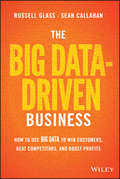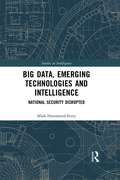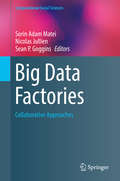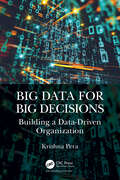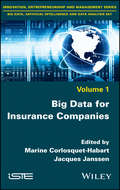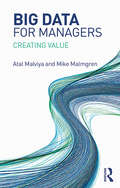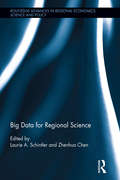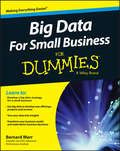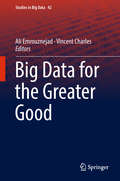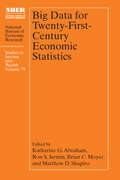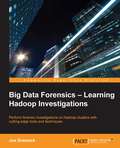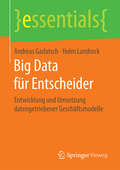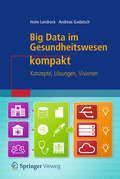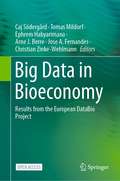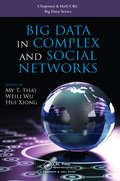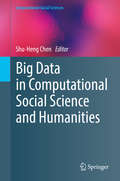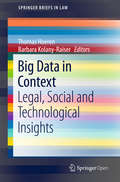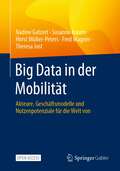- Table View
- List View
The Big Data-Driven Business: How to Use Big Data to Win Customers, Beat Competitors, and Boost Profits
by Russell Glass Sean CallahanGet the expert perspective and practical advice on big data The Big Data-Driven Business: How to Use Big Data to Win Customers, Beat Competitors, and Boost Profits makes the case that big data is for real, and more than just big hype. The book uses real-life examples—from Nate Silver to Copernicus, and Apple to Blackberry—to demonstrate how the winners of the future will use big data to seek the truth. Written by a marketing journalist and the CEO of a multi-million-dollar B2B marketing platform that reaches more than 90% of the U.S. business population, this book is a comprehensive and accessible guide on how to win customers, beat competitors, and boost the bottom line with big data. The marketplace has entered an era where the customer holds all the cards. With unprecedented choice in both the consumer world and the B2B world, it's imperative that businesses gain a greater understanding of their customers and prospects. Big data is the key to this insight, because it provides a comprehensive view of a company's customers—who they are, and who they may be tomorrow. The Big Data-Driven Business is a complete guide to the future of business as seen through the lens of big data, with expert advice on real-world applications. Learn what big data is, and how it will transform the enterprise Explore why major corporations are betting their companies on marketing technology Read case studies of big data winners and losers Discover how to change privacy and security, and remodel marketing Better information allows for better decisions, better targeting, and better reach. Big data has become an indispensable tool for the most effective marketers in the business, and it's becoming less of a competitive advantage and more like an industry standard. Remaining relevant as the marketplace evolves requires a full understanding and application of big data, and The Big Data-Driven Business provides the practical guidance businesses need.
Big Data, Emerging Technologies and Intelligence: National Security Disrupted (Studies in Intelligence)
by Miah Hammond-ErreyThis book sets out the big data landscape, comprising data abundance, digital connectivity and ubiquitous technology, and shows how the big data landscape and the emerging technologies it fuels are impacting national security.This book illustrates that big data is transforming intelligence production as well as changing the national security environment broadly, including what is considered a part of national security as well as the relationships agencies have with the public. The book highlights the impact of big data on intelligence production and national security from the perspective of Australian national security leaders and practitioners, and the research is based on empirical data collection, with insights from nearly 50 participants from within Australia’s National Intelligence Community. It argues that big data is transforming intelligence and national security and shows that the impacts of big data on the knowledge, activities and organisation of intelligence agencies is challenging some foundational intelligence principles, including the distinction between foreign and domestic intelligence collection. Furthermore, the book argues that big data has created emerging threats to national security; for example, it enables invasive targeting and surveillance, drives information warfare as well as social and political interference, and challenges the existing models of harm assessment used in national security. The book maps broad areas of change for intelligence agencies in the national security context and what they mean for intelligence communities, and explores how intelligence agencies look out to the rest of society, considering specific impacts relating to privacy, ethics and trust.This book will be of much interest to students of intelligence studies, technology studies, national security and International Relations.
Big Data, Emerging Technologies and Intelligence: National Security Disrupted (Studies in Intelligence)
by Miah Hammond-ErreyThis book sets out the big data landscape, comprising data abundance, digital connectivity and ubiquitous technology, and shows how the big data landscape and the emerging technologies it fuels are impacting national security.This book illustrates that big data is transforming intelligence production as well as changing the national security environment broadly, including what is considered a part of national security as well as the relationships agencies have with the public. The book highlights the impact of big data on intelligence production and national security from the perspective of Australian national security leaders and practitioners, and the research is based on empirical data collection, with insights from nearly 50 participants from within Australia’s National Intelligence Community. It argues that big data is transforming intelligence and national security and shows that the impacts of big data on the knowledge, activities and organisation of intelligence agencies is challenging some foundational intelligence principles, including the distinction between foreign and domestic intelligence collection. Furthermore, the book argues that big data has created emerging threats to national security; for example, it enables invasive targeting and surveillance, drives information warfare as well as social and political interference, and challenges the existing models of harm assessment used in national security. The book maps broad areas of change for intelligence agencies in the national security context and what they mean for intelligence communities, and explores how intelligence agencies look out to the rest of society, considering specific impacts relating to privacy, ethics and trust.This book will be of much interest to students of intelligence studies, technology studies, national security and International Relations.
Big Data Factories: Collaborative Approaches (Computational Social Sciences)
by Sorin Adam Matei Nicolas Jullien Sean P. GogginsThe book proposes a systematic approach to big data collection, documentation and development of analytic procedures that foster collaboration on a large scale. This approach, designated as “data factoring” emphasizes the need to think of each individual dataset developed by an individual project as part of a broader data ecosystem, easily accessible and exploitable by parties not directly involved with data collection and documentation. Furthermore, data factoring uses and encourages pre-analytic operations that add value to big data sets, especially recombining and repurposing.The book proposes a research-development agenda that can undergird an ideal data factory approach. Several programmatic chapters discuss specialized issues involved in data factoring (documentation, meta-data specification, building flexible, yet comprehensive data ontologies, usability issues involved in collaborative tools, etc.). The book also presents case studies for data factoring and processing that can lead to building better scientific collaboration and data sharing strategies and tools.Finally, the book presents the teaching utility of data factoring and the ethical and privacy concerns related to it.Chapter 9 of this book is available open access under a CC BY 4.0 license at link.springer.com
Big Data for Big Decisions: Building a Data-Driven Organization
by Krishna PeraBuilding a data-driven organization (DDO) is an enterprise-wide initiative that may consume and lock up resources for the long term. Understandably, any organization considering such an initiative would insist on a roadmap and business case to be prepared and evaluated prior to approval. This book presents a step-by-step methodology in order to create a roadmap and business case, and provides a narration of the constraints and experiences of managers who have attempted the setting up of DDOs. The emphasis is on the big decisions – the key decisions that influence 90% of business outcomes – starting from decision first and reengineering the data to the decisions process-chain and data governance, so as to ensure the right data are available at the right time, every time. Investing in artificial intelligence and data-driven decision making are now being considered a survival necessity for organizations to stay competitive. While every enterprise aspires to become 100% data-driven and every Chief Information Officer (CIO) has a budget, Gartner estimates over 80% of all analytics projects fail to deliver intended value. Most CIOs think a data-driven organization is a distant dream, especially while they are still struggling to explain the value from analytics. They know a few isolated successes, or a one-time leveraging of big data for decision making does not make an organization data-driven. As of now, there is no precise definition for data-driven organization or what qualifies an organization to call itself data-driven. Given the hype in the market for big data, analytics and AI, every CIO has a budget for analytics, but very little clarity on where to begin or how to choose and prioritize the analytics projects. Most end up investing in a visualization platform like Tableau or QlikView, which in essence is an improved version of their BI dashboard that the organization had invested into not too long ago. The most important stakeholders, the decision-makers, are rarely kept in the loop while choosing analytics projects. This book provides a fail-safe methodology for assured success in deriving intended value from investments into analytics. It is a practitioners’ handbook for creating a step-by-step transformational roadmap prioritizing the big data for the big decisions, the 10% of decisions that influence 90% of business outcomes, and delivering material improvements in the quality of decisions, as well as measurable value from analytics investments. The acid test for a data-driven organization is when all the big decisions, especially top-level strategic decisions, are taken based on data and not on the collective gut feeling of the decision makers in the organization.
Big Data for Big Decisions: Building a Data-Driven Organization
by Krishna PeraBuilding a data-driven organization (DDO) is an enterprise-wide initiative that may consume and lock up resources for the long term. Understandably, any organization considering such an initiative would insist on a roadmap and business case to be prepared and evaluated prior to approval. This book presents a step-by-step methodology in order to create a roadmap and business case, and provides a narration of the constraints and experiences of managers who have attempted the setting up of DDOs. The emphasis is on the big decisions – the key decisions that influence 90% of business outcomes – starting from decision first and reengineering the data to the decisions process-chain and data governance, so as to ensure the right data are available at the right time, every time. Investing in artificial intelligence and data-driven decision making are now being considered a survival necessity for organizations to stay competitive. While every enterprise aspires to become 100% data-driven and every Chief Information Officer (CIO) has a budget, Gartner estimates over 80% of all analytics projects fail to deliver intended value. Most CIOs think a data-driven organization is a distant dream, especially while they are still struggling to explain the value from analytics. They know a few isolated successes, or a one-time leveraging of big data for decision making does not make an organization data-driven. As of now, there is no precise definition for data-driven organization or what qualifies an organization to call itself data-driven. Given the hype in the market for big data, analytics and AI, every CIO has a budget for analytics, but very little clarity on where to begin or how to choose and prioritize the analytics projects. Most end up investing in a visualization platform like Tableau or QlikView, which in essence is an improved version of their BI dashboard that the organization had invested into not too long ago. The most important stakeholders, the decision-makers, are rarely kept in the loop while choosing analytics projects. This book provides a fail-safe methodology for assured success in deriving intended value from investments into analytics. It is a practitioners’ handbook for creating a step-by-step transformational roadmap prioritizing the big data for the big decisions, the 10% of decisions that influence 90% of business outcomes, and delivering material improvements in the quality of decisions, as well as measurable value from analytics investments. The acid test for a data-driven organization is when all the big decisions, especially top-level strategic decisions, are taken based on data and not on the collective gut feeling of the decision makers in the organization.
Big Data for Insurance Companies
by Marine Corlosquet-Habart Jacques JanssenThis book will be a "must" for people who want good knowledge of big data concepts and their applications in the real world, particularly in the field of insurance. It will be useful to people working in finance and to masters students using big data tools. The authors present the bases of big data: data analysis methods, learning processes, application to insurance and position within the insurance market. Individual chapters a will be written by well-known authors in this field.
Big Data for Insurance Companies
by Marine Corlosquet-Habart Jacques JanssenThis book will be a "must" for people who want good knowledge of big data concepts and their applications in the real world, particularly in the field of insurance. It will be useful to people working in finance and to masters students using big data tools. The authors present the bases of big data: data analysis methods, learning processes, application to insurance and position within the insurance market. Individual chapters a will be written by well-known authors in this field.
Big Data for Managers: Creating Value
by Atal Malviya Mike MalmgrenIn today’s fast growing digital world, the web, mobile, social networks and other digital platforms are producing enormous amounts of data that hold intelligence and valuable information. Correctly used it has the power to create sustainable value in different forms for businesses. The commonly used term for this data is Big Data, which includes structured, unstructured and hybrid structured data. However, Big Data is of limited value unless insightful information can be extracted from the sources of data. The solution is Big Data analytics, and how managers and executives can capture value from this vast resource of information and insights. This book develops a simple framework and a non-technical approach to help the reader understand, digest and analyze data, and produce meaningful analytics to make informed decisions. It will support value creation within businesses, from customer care to product innovation, from sales and marketing to operational performance. The authors provide multiple case studies on global industries and business units, chapter summaries and discussion questions for the reader to consider and explore. Big Data for Managers also presents small cases and challenges for the reader to work on – making this a thorough and practical guide for students and managers.
Big Data for Managers: Creating Value
by Atal Malviya Mike MalmgrenIn today’s fast growing digital world, the web, mobile, social networks and other digital platforms are producing enormous amounts of data that hold intelligence and valuable information. Correctly used it has the power to create sustainable value in different forms for businesses. The commonly used term for this data is Big Data, which includes structured, unstructured and hybrid structured data. However, Big Data is of limited value unless insightful information can be extracted from the sources of data. The solution is Big Data analytics, and how managers and executives can capture value from this vast resource of information and insights. This book develops a simple framework and a non-technical approach to help the reader understand, digest and analyze data, and produce meaningful analytics to make informed decisions. It will support value creation within businesses, from customer care to product innovation, from sales and marketing to operational performance. The authors provide multiple case studies on global industries and business units, chapter summaries and discussion questions for the reader to consider and explore. Big Data for Managers also presents small cases and challenges for the reader to work on – making this a thorough and practical guide for students and managers.
Big Data for Regional Science (Routledge Advances in Regional Economics, Science and Policy)
Recent technological advancements and other related factors and trends are contributing to the production of an astoundingly large and rapidly accelerating collection of data, or ‘Big Data’. This data now allows us to examine urban and regional phenomena in ways that were previously not possible. Despite the tremendous potential of big data for regional science, its use and application in this context is fraught with issues and challenges. This book brings together leading contributors to present an interdisciplinary, agenda-setting and action-oriented platform for research and practice in the urban and regional community. This book provides a comprehensive, multidisciplinary and cutting-edge perspective on big data for regional science. Chapters contain a collection of research notes contributed by experts from all over the world with a wide array of disciplinary backgrounds. The content is organized along four themes: sources of big data; integration, processing and management of big data; analytics for big data; and, higher level policy and programmatic considerations. As well as concisely and comprehensively synthesising work done to date, the book also considers future challenges and prospects for the use of big data in regional science. Big Data for Regional Science provides a seminal contribution to the field of regional science and will appeal to a broad audience, including those at all levels of academia, industry, and government.
Big Data for Regional Science (Routledge Advances in Regional Economics, Science and Policy)
Recent technological advancements and other related factors and trends are contributing to the production of an astoundingly large and rapidly accelerating collection of data, or ‘Big Data’. This data now allows us to examine urban and regional phenomena in ways that were previously not possible. Despite the tremendous potential of big data for regional science, its use and application in this context is fraught with issues and challenges. This book brings together leading contributors to present an interdisciplinary, agenda-setting and action-oriented platform for research and practice in the urban and regional community. This book provides a comprehensive, multidisciplinary and cutting-edge perspective on big data for regional science. Chapters contain a collection of research notes contributed by experts from all over the world with a wide array of disciplinary backgrounds. The content is organized along four themes: sources of big data; integration, processing and management of big data; analytics for big data; and, higher level policy and programmatic considerations. As well as concisely and comprehensively synthesising work done to date, the book also considers future challenges and prospects for the use of big data in regional science. Big Data for Regional Science provides a seminal contribution to the field of regional science and will appeal to a broad audience, including those at all levels of academia, industry, and government.
Big Data For Small Business For Dummies
by Bernard MarrCapitalise on big data to add value to your small business Written by bestselling author and big data expert Bernard Marr, Big Data For Small Business For Dummies helps you understand what big data actually is—and how you can analyse and use it to improve your business. Free of confusing jargon and complemented with lots of step-by-step guidance and helpful advice, it quickly and painlessly helps you get the most from using big data in a small business. Business data has been around for a long time. Unfortunately, it was trapped away in overcrowded filing cabinets and on archaic floppy disks. Now, thanks to technology and new tools that display complex databases in a much simpler manner, small businesses can benefit from the big data that's been hiding right under their noses. With the help of this friendly guide, you'll discover how to get your hands on big data to develop new offerings, products and services; understand technological change; create an infrastructure; develop strategies; and make smarter business decisions. Shows you how to use big data to make sense of user activity on social networks and customer transactions Demonstrates how to capture, store, search, share, analyse and visualise analytics Helps you turn your data into actionable insights Explains how to use big data to your advantage in order to transform your small business If you're a small business owner or employee, Big Data For Small Business For Dummies helps you harness the hottest commodity on the market today in order to take your company to new heights.
Big Data For Small Business For Dummies
by Bernard MarrCapitalise on big data to add value to your small business Written by bestselling author and big data expert Bernard Marr, Big Data For Small Business For Dummies helps you understand what big data actually is—and how you can analyse and use it to improve your business. Free of confusing jargon and complemented with lots of step-by-step guidance and helpful advice, it quickly and painlessly helps you get the most from using big data in a small business. Business data has been around for a long time. Unfortunately, it was trapped away in overcrowded filing cabinets and on archaic floppy disks. Now, thanks to technology and new tools that display complex databases in a much simpler manner, small businesses can benefit from the big data that's been hiding right under their noses. With the help of this friendly guide, you'll discover how to get your hands on big data to develop new offerings, products and services; understand technological change; create an infrastructure; develop strategies; and make smarter business decisions. Shows you how to use big data to make sense of user activity on social networks and customer transactions Demonstrates how to capture, store, search, share, analyse and visualise analytics Helps you turn your data into actionable insights Explains how to use big data to your advantage in order to transform your small business If you're a small business owner or employee, Big Data For Small Business For Dummies helps you harness the hottest commodity on the market today in order to take your company to new heights.
Big Data for the Greater Good (Studies in Big Data #42)
by Ali Emrouznejad Vincent CharlesThis book highlights some of the most fascinating current uses, thought-provoking changes, and biggest challenges that Big Data means for our society. The explosive growth of data and advances in Big Data analytics have created a new frontier for innovation, competition, productivity, and well-being in almost every sector of our society, as well as a source of immense economic and societal value. From the derivation of customer feedback-based insights to fraud detection and preserving privacy; better medical treatments; agriculture and food management; and establishing low-voltage networks – many innovations for the greater good can stem from Big Data. Given the insights it provides, this book will be of interest to both researchers in the field of Big Data, and practitioners from various fields who intend to apply Big Data technologies to improve their strategic and operational decision-making processes.
Big Data for Twenty-First-Century Economic Statistics (National Bureau of Economic Research Studies in Income and Wealth #79)
by Katharine G. Abraham, Ron S. Jarmin, Brian C. Moyer, and Matthew D. ShapiroThe papers in this volume analyze the deployment of Big Data to solve both existing and novel challenges in economic measurement. The existing infrastructure for the production of key economic statistics relies heavily on data collected through sample surveys and periodic censuses, together with administrative records generated in connection with tax administration. The increasing difficulty of obtaining survey and census responses threatens the viability of existing data collection approaches. The growing availability of new sources of Big Data—such as scanner data on purchases, credit card transaction records, payroll information, and prices of various goods scraped from the websites of online sellers—has changed the data landscape. These new sources of data hold the promise of allowing the statistical agencies to produce more accurate, more disaggregated, and more timely economic data to meet the needs of policymakers and other data users. This volume documents progress made toward that goal and the challenges to be overcome to realize the full potential of Big Data in the production of economic statistics. It describes the deployment of Big Data to solve both existing and novel challenges in economic measurement, and it will be of interest to statistical agency staff, academic researchers, and serious users of economic statistics.
Big Data for Twenty-First-Century Economic Statistics (National Bureau of Economic Research Studies in Income and Wealth #79)
The papers in this volume analyze the deployment of Big Data to solve both existing and novel challenges in economic measurement. The existing infrastructure for the production of key economic statistics relies heavily on data collected through sample surveys and periodic censuses, together with administrative records generated in connection with tax administration. The increasing difficulty of obtaining survey and census responses threatens the viability of existing data collection approaches. The growing availability of new sources of Big Data—such as scanner data on purchases, credit card transaction records, payroll information, and prices of various goods scraped from the websites of online sellers—has changed the data landscape. These new sources of data hold the promise of allowing the statistical agencies to produce more accurate, more disaggregated, and more timely economic data to meet the needs of policymakers and other data users. This volume documents progress made toward that goal and the challenges to be overcome to realize the full potential of Big Data in the production of economic statistics. It describes the deployment of Big Data to solve both existing and novel challenges in economic measurement, and it will be of interest to statistical agency staff, academic researchers, and serious users of economic statistics.
Big Data Forensics – Learning Hadoop Investigations
by Joe SremackPerform forensic investigations on Hadoop clusters with cutting-edge tools and techniques About This Book • Identify, collect, and analyze Hadoop evidence forensically • Learn about Hadoop's internals and Big Data file storage concepts • A step-by-step guide to help you perform forensic analysis using freely available tools Who This Book Is For This book is meant for statisticians and forensic analysts with basic knowledge of digital forensics. They do not need to know Big Data Forensics. If you are an IT professional, law enforcement professional, legal professional, or a student interested in Big Data and forensics, this book is the perfect hands-on guide for learning how to conduct Hadoop forensic investigations. Each topic and step in the forensic process is described in accessible language. What You Will Learn • Understand Hadoop internals and file storage • Collect and analyze Hadoop forensic evidence • Perform complex forensic analysis for fraud and other investigations • Use state-of-the-art forensic tools • Conduct interviews to identify Hadoop evidence • Create compelling presentations of your forensic findings • Understand how Big Data clusters operate • Apply advanced forensic techniques in an investigation, including file carving, statistical analysis, and more In Detail Big Data forensics is an important type of digital investigation that involves the identification, collection, and analysis of large-scale Big Data systems. Hadoop is one of the most popular Big Data solutions, and forensically investigating a Hadoop cluster requires specialized tools and techniques. With the explosion of Big Data, forensic investigators need to be prepared to analyze the petabytes of data stored in Hadoop clusters. Understanding Hadoop's operational structure and performing forensic analysis with court-accepted tools and best practices will help you conduct a successful investigation. Discover how to perform a complete forensic investigation of large-scale Hadoop clusters using the same tools and techniques employed by forensic experts. This book begins by taking you through the process of forensic investigation and the pitfalls to avoid. It will walk you through Hadoop's internals and architecture, and you will discover what types of information Hadoop stores and how to access that data. You will learn to identify Big Data evidence using techniques to survey a live system and interview witnesses. After setting up your own Hadoop system, you will collect evidence using techniques such as forensic imaging and application-based extractions. You will analyze Hadoop evidence using advanced tools and techniques to uncover events and statistical information. Finally, data visualization and evidence presentation techniques are covered to help you properly communicate your findings to any audience. Style and approach This book is a complete guide that follows every step of the forensic analysis process in detail. You will be guided through each key topic and step necessary to perform an investigation. Hands-on exercises are presented throughout the book, and technical reference guides and sample documents are included for real-world use.
Big Data für Entscheider: Entwicklung und Umsetzung datengetriebener Geschäftsmodelle (essentials)
by Andreas Gadatsch Holm LandrockAndreas Gadatsch und Holm Landrock zeigen an typischen Beispielen aus der Praxis, wie datengetriebene Geschäftsmodelle entstehen. Sie erläutern, wie sich Big-Data-Projekte rechnen und wie man am einfachsten an die Analyse großer Datenmengen herangeht. Eine Bewertung der zentralen Aspekte von Projekten und der dort eingesetzten Technologien erleichtert den Lesern die tägliche Praxis im IT-Management. Die Autoren stellen Hadoop als eine der wichtigen Big-Data-Technologien vor.
Big Data im Gesundheitswesen kompakt: Konzepte, Lösungen, Visionen (IT kompakt)
by Holm Landrock Andreas GadatschDas kompakte Fachbuch gibt einen Überblick über die Möglichkeiten von „Big Data“ im Gesundheitswesen und beschreibt anhand von ausgewählten Szenarien mögliche Einsatzgebiete.Die Autoren erläutern zentrale Systemkomponenten und IT-Standards und thematisieren anhand wichtiger Daten des Gesundheitswesens die Notwendigkeit der Strukturierung und Modellierung von Daten. Das Buch gibt Hinweise wie Geschäftsprozesse im Gesundheitswesen dokumentiert, analysiert und verbessert werden können. Anwendungsszenarien, wie die Datenanalysen für Krankenhäuser, Labore, Versicherungen und die Pharmaindustrie, zeigen die praktische Relevanz des Themas. Aber auch rechtliche und ethische Aspekte werden inhaltlich angeschnitten.Ein Buch für Entscheider in der medizinischen Leitung und Verwaltung von Krankenhäusern, Fachleute sowie niedergelassene Ärzte und Apotheker, aber auch Personen in Ausbildung und Studium im Gesundheitswesen.
Big Data in Bioeconomy: Results from the European DataBio Project
by Christian Zinke-Wehlmann Caj Södergård Tomas Mildorf Ephrem Habyarimana Arne J. Berre Jose A. FernandesThis edited open access book presents the comprehensive outcome of The European DataBio Project, which examined new data-driven methods to shape a bioeconomy. These methods are used to develop new and sustainable ways to use forest, farm and fishery resources. As a European initiative, the goal is to use these new findings to support decision-makers and producers – meaning farmers, land and forest owners and fishermen.With their 27 pilot projects from 17 countries, the authors examine important sectors and highlight examples where modern data-driven methods were used to increase sustainability. How can farmers, foresters or fishermen use these insights in their daily lives? The authors answer this and other questions for our readers. The first four parts of this book give an overview of the big data technologies relevant for optimal raw material gathering. The next three parts put these technologies into perspective, by showing useable applications from farming, forestry and fishery. The final part of this book gives a summary and a view on the future.With its broad outlook and variety of topics, this book is an enrichment for students and scientists in bioeconomy, biodiversity and renewable resources.
Big Data in Complex and Social Networks (Chapman & Hall/CRC Big Data Series)
by My T. Thai Weili Wu Hui XiongThis book presents recent developments on the theoretical, algorithmic, and application aspects of Big Data in Complex and Social Networks. The book consists of four parts, covering a wide range of topics. The first part of the book focuses on data storage and data processing. It explores how the efficient storage of data can fundamentally support intensive data access and queries, which enables sophisticated analysis. It also looks at how data processing and visualization help to communicate information clearly and efficiently. The second part of the book is devoted to the extraction of essential information and the prediction of web content. The book shows how Big Data analysis can be used to understand the interests, location, and search history of users and provide more accurate predictions of User Behavior. The latter two parts of the book cover the protection of privacy and security, and emergent applications of big data and social networks. It analyzes how to model rumor diffusion, identify misinformation from massive data, and design intervention strategies. Applications of big data and social networks in multilayer networks and multiparty systems are also covered in-depth.
Big Data in Computational Social Science and Humanities (Computational Social Sciences)
by Shu-Heng ChenThis edited volume focuses on big data implications for computational social science and humanities from management to usage. The first part of the book covers geographic data, text corpus data, and social media data, and exemplifies their concrete applications in a wide range of fields including anthropology, economics, finance, geography, history, linguistics, political science, psychology, public health, and mass communications. The second part of the book provides a panoramic view of the development of big data in the fields of computational social sciences and humanities. The following questions are addressed: why is there a need for novel data governance for this new type of data?, why is big data important for social scientists?, and how will it revolutionize the way social scientists conduct research? With the advent of the information age and technologies such as Web 2.0, ubiquitous computing, wearable devices, and the Internet of Things, digital society has fundamentally changed what we now know as "data", the very use of this data, and what we now call "knowledge". Big data has become the standard in social sciences, and has made these sciences more computational. Big Data in Computational Social Science and Humanities will appeal to graduate students and researchers working in the many subfields of the social sciences and humanities.
Big Data in Context: Legal, Social and Technological Insights (SpringerBriefs in Law)
by Thomas Hoeren Barbara Kolany-RaiserThis book is open access under a CC BY 4.0 license.This book sheds new light on a selection of big data scenarios from an interdisciplinary perspective. It features legal, sociological and economic approaches to fundamental big data topics such as privacy, data quality and the ECJ’s Safe Harbor decision on the one hand, and practical applications such as smart cars, wearables and web tracking on the other. Addressing the interests of researchers and practitioners alike, it provides a comprehensive overview of and introduction to the emerging challenges regarding big data.All contributions are based on papers submitted in connection with ABIDA (Assessing Big Data), an interdisciplinary research project exploring the societal aspects of big data and funded by the German Federal Ministry of Education and Research.This volume was produced as a part of the ABIDA project (Assessing Big Data, 01IS15016A-F). ABIDA is a four-year collaborative project funded by the Federal Ministry of Education and Research. However the views and opinions expressed in this book reflect only the authors’ point of view and not necessarily those of all members of the ABIDA project or the Federal Ministry of Education and Research.
Big Data in der Mobilität: Akteure, Geschäftsmodelle und Nutzenpotenziale für die Welt von morgen
by Nadine Gatzert Susanne Knorre Horst Müller-Peters Fred Wagner Theresa JostDieses Open-Access-Buch befasst sich mit den gesellschaftlich und wirtschaftlich weitreichenden Potenzialen von „Big Data in der Mobilität“. Zunächst werden der Mobilitätsmarkt mit seinen Akteuren sowie deren Interessen und oft paradoxen Verhaltensweisen vorgestellt sowie eine „Mobilitäts-Datenkarte“ abgeleitet. Darauf aufbauend werden auf Basis mehrerer empirischer Studien die Chancen und Risiken der Datenerhebung und deren Nutzung für neue Geschäftsmodelle und das Gemeinwohl, nicht zuletzt den Klimaschutz, analysiert. Daraus werden Nutzenpotenziale „für die Welt von morgen“ abgeleitet und die notwendigen politischen und gesellschaftlichen Voraussetzungen skizziert. Ein Ausblick auf die Zukunft der Mobilität und Implikationen für betroffene Branchen – am Beispiel der Versicherungswirtschaft – runden das Buch ab.
